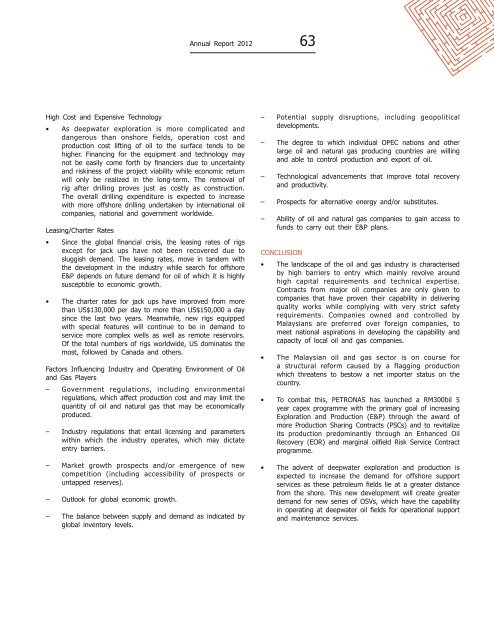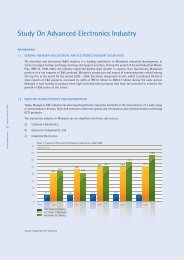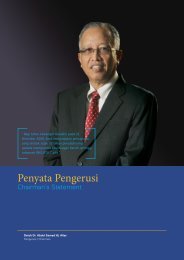Oil and Gas Industry
oil and gas indUstrY - Bank Pembangunan Malaysia Berhad
oil and gas indUstrY - Bank Pembangunan Malaysia Berhad
You also want an ePaper? Increase the reach of your titles
YUMPU automatically turns print PDFs into web optimized ePapers that Google loves.
Annual Report 2012 63High Cost <strong>and</strong> Expensive Technology• As deepwater exploration is more complicated <strong>and</strong>dangerous than onshore fields, operation cost <strong>and</strong>production cost lifting of oil to the surface tends to behigher. Financing for the equipment <strong>and</strong> technology maynot be easily come forth by financiers due to uncertainty<strong>and</strong> riskiness of the project viability while economic returnwill only be realized in the long-term. The removal ofrig after drilling proves just as costly as construction.The overall drilling expenditure is expected to increasewith more offshore drilling undertaken by international oilcompanies, national <strong>and</strong> government worldwide.Leasing/Charter Rates• Since the global financial crisis, the leasing rates of rigsexcept for jack ups have not been recovered due tosluggish dem<strong>and</strong>. The leasing rates, move in t<strong>and</strong>em withthe development in the industry while search for offshoreE&P depends on future dem<strong>and</strong> for oil of which it is highlysusceptible to economic growth.• The charter rates for jack ups have improved from morethan US$130,000 per day to more than US$150,000 a daysince the last two years. Meanwhile, new rigs equippedwith special features will continue to be in dem<strong>and</strong> toservice more complex wells as well as remote reservoirs.Of the total numbers of rigs worldwide, US dominates themost, followed by Canada <strong>and</strong> others.Factors Influencing <strong>Industry</strong> <strong>and</strong> Operating Environment of <strong>Oil</strong><strong>and</strong> <strong>Gas</strong> Players– Government regulations, including environmentalregulations, which affect production cost <strong>and</strong> may limit thequantity of oil <strong>and</strong> natural gas that may be economicallyproduced.– <strong>Industry</strong> regulations that entail licensing <strong>and</strong> parameterswithin which the industry operates, which may dictateentry barriers.– Market growth prospects <strong>and</strong>/or emergence of newcompetition (including accessibility of prospects oruntapped reserves).– Outlook for global economic growth.– The balance between supply <strong>and</strong> dem<strong>and</strong> as indicated byglobal inventory levels.– Potential supply disruptions, including geopoliticaldevelopments.– The degree to which individual OPEC nations <strong>and</strong> otherlarge oil <strong>and</strong> natural gas producing countries are willing<strong>and</strong> able to control production <strong>and</strong> export of oil.– Technological advancements that improve total recovery<strong>and</strong> productivity.– Prospects for alternative energy <strong>and</strong>/or substitutes.– Ability of oil <strong>and</strong> natural gas companies to gain access tofunds to carry out their E&P plans.Conclusion• The l<strong>and</strong>scape of the oil <strong>and</strong> gas industry is characterisedby high barriers to entry which mainly revolve aroundhigh capital requirements <strong>and</strong> technical expertise.Contracts from major oil companies are only given tocompanies that have proven their capability in deliveringquality works while complying with very strict safetyrequirements. Companies owned <strong>and</strong> controlled byMalaysians are preferred over foreign companies, tomeet national aspirations in developing the capability <strong>and</strong>capacity of local oil <strong>and</strong> gas companies.• The Malaysian oil <strong>and</strong> gas sector is on course fora structural reform caused by a flagging productionwhich threatens to bestow a net importer status on thecountry.• To combat this, PETRONAS has launched a RM300bil 5year capex programme with the primary goal of increasingExploration <strong>and</strong> Production (E&P) through the award ofmore Production Sharing Contracts (PSCs) <strong>and</strong> to revitalizeits production predominantly through an Enhanced <strong>Oil</strong>Recovery (EOR) <strong>and</strong> marginal oilfield Risk Service Contractprogramme.• The advent of deepwater exploration <strong>and</strong> production isexpected to increase the dem<strong>and</strong> for offshore supportservices as these petroleum fields lie at a greater distancefrom the shore. This new development will create greaterdem<strong>and</strong> for new series of OSVs, which have the capabilityin operating at deepwater oil fields for operational support<strong>and</strong> maintenance services.





